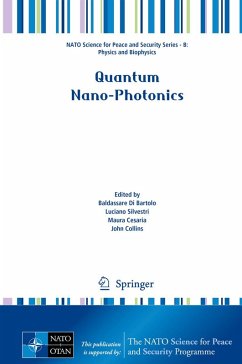Quantum Nano-Photonics (eBook, PDF)
Redaktion: Di Bartolo, Baldassare; Collins, John; Cesaria, Maura; Silvestri, Luciano
Quantum Nano-Photonics (eBook, PDF)
Redaktion: Di Bartolo, Baldassare; Collins, John; Cesaria, Maura; Silvestri, Luciano
- Format: PDF
- Merkliste
- Auf die Merkliste
- Bewerten Bewerten
- Teilen
- Produkt teilen
- Produkterinnerung
- Produkterinnerung

Hier können Sie sich einloggen

Bitte loggen Sie sich zunächst in Ihr Kundenkonto ein oder registrieren Sie sich bei bücher.de, um das eBook-Abo tolino select nutzen zu können.
This book brings together more closely researchers working in the two fields of quantum optics and nano-optics and provides a general overview of the main topics of interest in applied and fundamental research. The contributions cover, for example, single-photon emitters and emitters of entangled photon pairs based on epitaxially grown semiconductor quantum dots, nitrogen vacancy centers in diamond as single-photon emitters, coupled quantum bits based on trapped ions, integrated waveguide superconducting nanowire single-photon detectors, quantum nano-plasmonics, nanosensing, quantum aspects of…mehr
- Geräte: PC
- ohne Kopierschutz
- eBook Hilfe
- Größe: 13.89MB
Dieser Download kann aus rechtlichen Gründen nur mit Rechnungsadresse in A, B, BG, CY, CZ, D, DK, EW, E, FIN, F, GR, HR, H, IRL, I, LT, L, LR, M, NL, PL, P, R, S, SLO, SK ausgeliefert werden.
- Produktdetails
- Verlag: Springer-Verlag GmbH
- Seitenzahl: 474
- Erscheinungstermin: 19. September 2018
- Englisch
- ISBN-13: 9789402415445
- Artikelnr.: 59950771
- Verlag: Springer-Verlag GmbH
- Seitenzahl: 474
- Erscheinungstermin: 19. September 2018
- Englisch
- ISBN-13: 9789402415445
- Artikelnr.: 59950771
